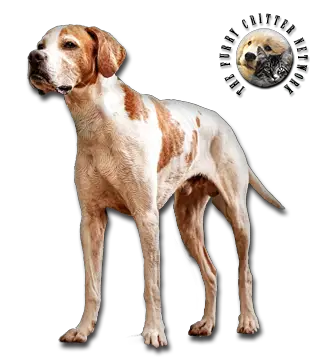Breed Standard
Head: Slender. Skull medium in length, flat. Pronounced stop. Pronounced occipital peak. Angular, slightly concave muzzle. Strong jaws. Thin lips. Wide nose.
Ears: Set on fairly high. Medium in length, thin, lying flat against the head, slightly pointed at the tips.
Eyes: Round, hazel or brown, depending on coat color.
Body: Square build. Long, muscular, slightly arched, without dewlap. Shoulder blades close together. Chest broad, well let-down. Well-sprung ribs. Solid, short, muscular, slightly clean-flanked loin. Straight back. Long croup.
Tail: Medium in length, thick at the base and tapering toward the tip. Carried level with the topline without curving upward. In action, wagged from side to side.
Hair: Fine, short, hard, smooth, straight, and very glossy.
Coat: Usual colors are lemon and white, orange and white, liver (brown) and white, and black and white. Whole-color and tricolor coats also allowed.
Size: Dog: 63 to 69 cm (24.8-27 in). Bitch: 61 to 66 cm (24-26 in).
Weight: 20 to 30 kg (44-66 lb).
History
There has been much debate among dog historians about the ancestry of the Pointer. The most commonly held position is that the breed descends from Old Spanish Pointers that were imported into England. The popular belief is that Spanish Pointers were first introduced to England in 1713 by soldiers returning from Spain after the Peace of Utrecht. In his Cynographia Britannica, published in 1800, Sydenham Edwards states that the "Spanish Pointer was introduced to this country (England) by a Portugal Merchant, at a very modern period, and was first used by a reduced Baron, of the name of Bichell, who lived in Norfolk.
Other early sources suggest Portuguese Pointers, Italian Braccos or French pointers were the foundation of the English breed. In 1902, Victorian era sportsman William Arkwright produced the book The pointer and his predecessors often considered one of the best early histories of the Pointer for which he expended considerable time and money searching continental archives. In the book he notes that he did not find any truly convincing evidence of Spanish Pointers being the foundation stock of the Pointer but still concludes on the basis of all evidence that it is the most likely history. It is noteworthy that in those days dog breeds did not exist as they are known in more modern times, and that a more general pointing type of dog (typically a short haired, hound-like, air-scenting dog with regional variations of appearance that was used for indicating the location of game birds) was known in all of these countries.
A second less commonly held belief is a form of Pointer that was present in England, much earlier than the introduction of the Spanish Pointer, and that they were used from medieval times to indicate the location of hares which were subsequently coursed by greyhounds or caught by hawks; it is held that these dogs were subsequently heavily influenced by the introduction of imported European pointer blood.
A compendium of sources state that in England early Pointers were crossed with other breeds to impart certain desirable traits, including setters, bloodhounds and foxhounds, with some mention of Bull Terriers and bulldogs. Early Pointers were comparatively heavy, ponderous dogs able to hold a steady point whilst the hunter readied his gun. With the steady improvement of firearms throughout the 18th and 19th centuries, faster and more agile dogs were sought so Greyhounds were increasingly introduced to add speed. The introduction of Greyhound blood resulted in the modern Pointer being a much finer dog with a comparatively tucked-up loin, tighter lips and low-set tail, more akin to that of the Greyhound than European pointer breeds.
The Pointer's breed standard was formally adopted in 1936 and has subsequently remained largely unchanged.
Behavior
This hardy, active, quick, and agile athlete with great endurance has two main attributes: his speed and his extraordinary, peerless nose. He excels in flat, open fields. His hunt is energetic, avid, steady, and extensive. His pointing (a "pointer" is a shorthaired dog that indicates the presence of game by standing still) is spectacular, confident, and steady. He appears almost sculpted, standing frozen with his body rigid, muscles tensed, head raised, and tail stiff and level with the topline. He is the most highly skilled pointer but not as good a retriever. He excels on woodcock, quail, pheasant, and partridge and will also tackle ground game. Easygoing and good-natured, the English Pointer is a very affectionate pet. He can be a watchdog. He needs firm but patient, gentle training.
He is not suited to city life. He needs wide open spaces and lots of exercise. He is sensitive to cold and dampness. He requires weekly brushing and regular attention to the ears.
Function
Hunting Dog, Companion Dog.
Health
The Pointer is considered a generally healthy breed, The Kennel Club does not recommend any genetic or screening tests be conducted for the breed. Known inherited conditions that have been found in the breed include hip dysplasia, elbow dysplasia, patella luxation, hereditary sensory neuropathy, spinal muscle atrophy, X-linked cerebellar ataxia and deafness. The breed has minor predispositions to hypothyroidism, demodicosis, cataracts, retinal dysplasia and corneal dystrophy.






